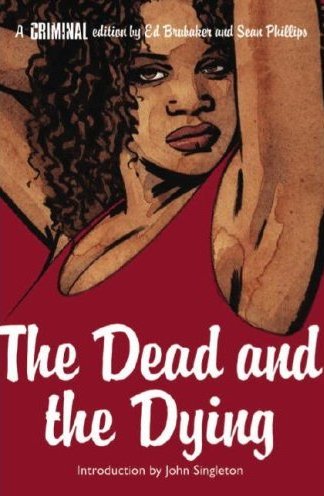 Coward
Coward
Titan Books, £9.99 ISBN 9781845766105
The Dead And The Dying
Titan Books £9.99 ISBN 9781848561519
By Ed Brubaker and Sean Phillips
Ed Brubaker is one of the best
writers of hard-boiled urban crime out there, but he may have flown under
your Shots radar, because Brubaker writes for the comics, and hasn’t yet,
like, say Brian Vaughn, who provides an introduction to The Dead And
The Dying, made the jump to classy TV like Lost. On the strength
of writing like this, there’s no reason he couldn’t be churning out TV
(the introduction to Coward comes from Tom Fontana, of Homicide
and Oz) or maybe those little straight to video movies that star
Mariel Hemingway or Marlee Matlin with young actors needing a break.
Coward is the story of
Leo, a young man who’s grown up in the world of thieves, and who can plan
a perfect heist better than anyone. When he’s strong-armed into a job
he doesn’t want to take, he sees the double-cross coming, but not the
way it’s going to happen. Other people get involved, and Leo finds himself
having to break all his own rules, knowing that the rules are the only
thing that keeps him safe in his life of crime. It sounds simple, and it
is, and it sounds somewhat cliched, and it’s that too. But it works partly
because you can get away with revisiting familiar tropes when you’re working
in graphic stories, in much the same way you can in the movies: it’s the
way the scenes unfold, and the new insights you get from the art that makes
the revisiting satisfying. Here Sean Phillips’ art seems influenced far
more by the small screen, television like The Wire, than, say, by
film noir movies of the forties, but that’s keeping in the tone of the
story: times have changed even if crime remains the same.
It also works because of the
skill with which Brubaker delineates his characters: the real sounds within
their thought balloons. Leo‘s specialty is getting out before he gets
involved, and that applies to life as well as theft. Brubaker keeps the
focus on Leo; the real battle is within him, and he has to fight it out
for himself. He moves in a corrupt world, and he’s trying to keep from
getting caught up in it, just stealing enough to get by. But we all live
in a corrupt world, and it’s hard just to keep getting by. It can quickly
become cowardice, and that’s what this excellent graphic novel is really
all about.
The Dead And The Dying also
plays with familiar elements, and this case Brubaker acknowledges the inspiration
of the classic noir film Out Of The Past (aka Build My Gallows
High, which was also the title of Daniel Mainwaring (aka Geoffrey Holmes)
novel). It’s a story taking place in the 1970s, but told in flashbacks,
starting with boxer Jake ’Gnarly’ Brown, and his childhood friendship
with Sebastian Hyde. Jake’s father was a hitman, but20he spared the life
of Sebastian’s father, and joined him in a take-over of the local mob,
becoming his right-hand man. The boys grew up together as best friends,
but Jake is black, while Sebastian is white and privileged; his dad is
the boss and he will be the boss one day.
Into this mix comes Danica Briggs,
daughter of Jake's boxing training. Although he's drawn to her, when Sebastian
shows interest in her, Jake defers to his friend, with tragic consequences.
Brubaker tells the story first with Jake in the (1970s) present, seeing
Danica back in town and remembering the past. Eventually, there will be
a falling out with Sebastian (the Whit Stillman/Kirk Douglas figure to
Jake's Jeff Bailey/Robert Mitchum, if you remember the movie). The circumstances
behind that falling out are detailed in the second part of the story, which
revolves around Tegg, a damaged Vietnam veteran, whom Danica uses to set
up Sebastian’s crime operation. And the final part of the story is Danica's,
told in flashback, and then to the present.
It's that last part that makes
this take on an old movie trope work so well: it changes the ultimate point
of view. In Out Of The Past Kathie Moffat (Jane Greer) has no backstory
to speak of, she exists as a classic film noir femme fatale, most interesting
for her role in the dynamic between Whit and Jeff. Brubaker's focus on
Danica does more than just reveal the mechanics of the plot; it makes her
the heart of the tale, and it makes the story more tragic and telling as
a result. Again, Phillips' art adds a fresh dimension to some familiar
material; he captures some of that dirty, grainy look of 70s crime and
exploitation movies, and mixes it with some classic norish shadow, the
mix works well. He and Brubaker complement each other well, and The
Dead And The Dying is one of the best noirs I've read in a while. Why
not try it on TV?
|





